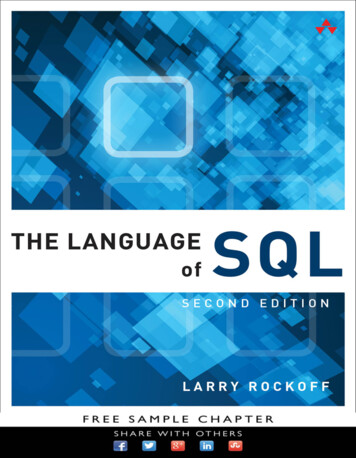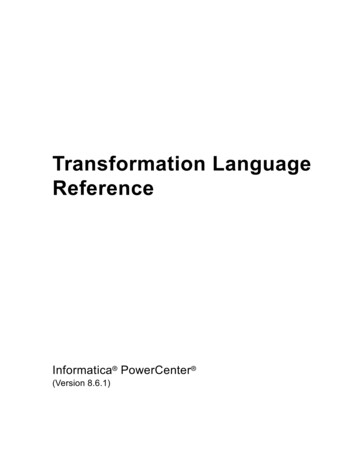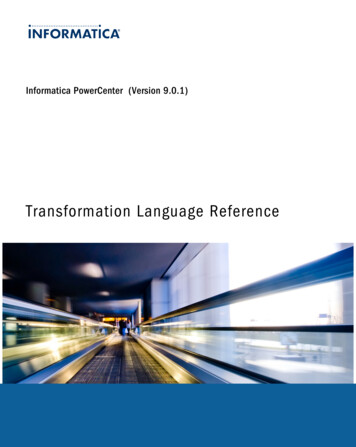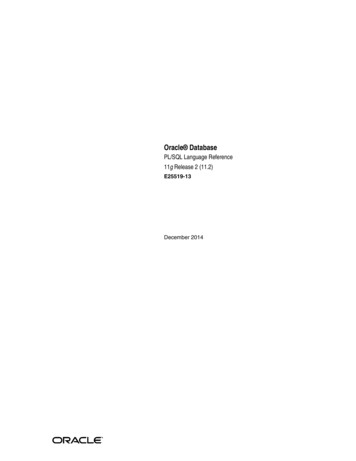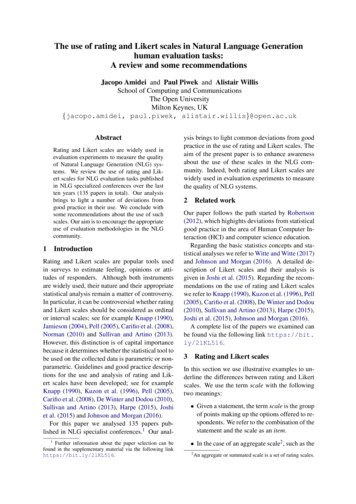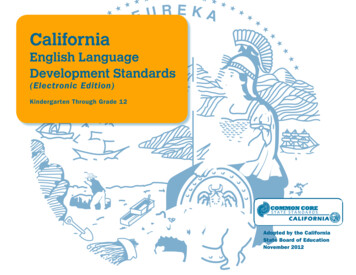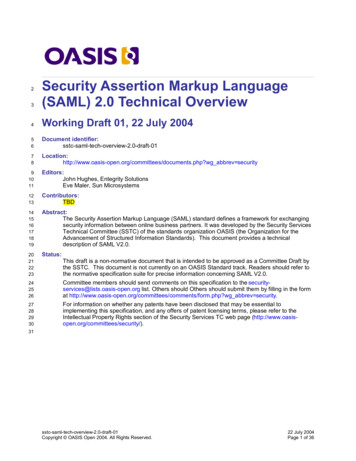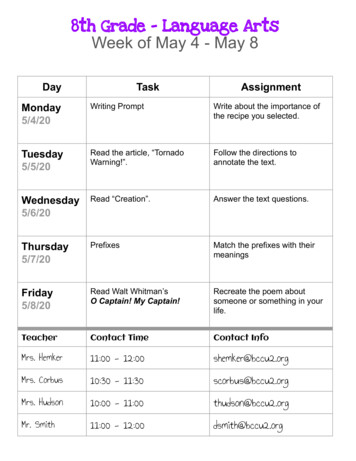
Transcription
THE IMPROVISATIONAL LANGUAGE OF NIELS-HENNING ØRSTED PEDERSEN:A PERFORMANCE STUDYCraig Butterfield, B.M., M.M.Dissertation Prepared for the Degree ofDOCTOR OF MUSICAL ARTSUNIVERSITY OF NORTH TEXASDecember 2008APPROVED:Jeff Bradetich, Major ProfessorLynn Seaton, Minor ProfessorJoseph Klein, Committee MemberTerri Sundberg, Chair of the Division ofInstrumental StudiesGraham Phipps, Director of Graduate Studies inthe College of MusicJames C. Scott, Dean of the College of MusicSandra L. Terrell, Dean of the Robert B. ToulouseSchool of Graduate Studies
Butterfield, Craig. The improvisational language of Niels-Henning Ørsted Pedersen: Aperformance study. Doctor of Musical Arts (Performance), December 2008, 69 pp., 103 musicalillustrations, works cited, 20 titles.Thirteen original transcriptions and subsequent analysis of improvised solos performedby Niels-Henning Ørsted Pedersen. The transcriptions are analyzed in three categories: harmonicvocabulary, technical devices, and motivic use. Pervasive harmonic and melodic themes arepresented and compared with phrases from improvisers such as Sonny Rollins and CharlieParker, as well as compositions by J.S. Bach and Johannes Brahms. Observations from thetranscriptions regarding performance practice and techniques unique to Pedersen as well as theinfluence of the physical characteristics of the double bass are discussed. Pedersen’s use ofmotivic development within a single solo is analyzed.
Copyright 2008byCraig Butterfieldii
TABLE OF CONTENTSPageChapters1.INTRODUCTION .12.ORIGINAL TRANSCRIPTIONS .4All the Things You AreBeautiful LoveBlues for PerlaFalling in Love with LoveHave You Met Miss JonesI Fall in Love too EasilyI Love YouLover ManOleoSomeday My Prince Will ComeStella by StarlightThere Is No Greater LoveYou Look Good to Me3.TRANSCRIPTION ANALYSIS .37Harmonic AnalysisTechnical DevicesMotivic UseREFERENCE LIST .68iii
CHAPTER 1INTRODUCTIONNiels-Henning Ørsted Pedersen was one of the most influential jazz bassists in the historyof the art form. In addition to possessing an unmatched technical facility on the instrument,1 heabsorbed and utilized the be-bop language, epitomized by Charlie Parker and Dizzy Gillespie,perhaps more eloquently than any other double bassist. Pedersen collaborated with many of theleading jazz artists, including Oscar Peterson, Joe Pass, Dexter Gordon, Sonny Rollins, BudPowell, Bill Evans, Chet Baker, Kenny Drew, Michel Petrucciani, and Tete Montoliu.Pedersen was born in 1946 in Osted, Denmark. After briefly studying piano, Pedersenswitched to double bass and began his professional career at the age of 14. At the age of 17,Pedersen had become the house bassist at the Club Montmartre in Copenhagen.2 He was thebassist of choice for jazz artists touring Europe and formed long-lasting musical relationshipswith Kenny Drew and Oscar Peterson, replacing Ray Brown as Peterson’s bassist in the 1970s.Niels-Henning Ørsted Pedersen preferred to remain in his native Denmark throughout his life,and combined be-bop and post-bop genres with Norwegian folk melodies in his owncompositions and recordings as a leader.There have not been any comprehensive studies done regarding his unique vocabularyand performance technique to date. In-depth analyses of a particular artist are invaluablepedagogical tools regardless of the genre, including Samuel Applebaum’s Way They Play seriesand David Baker’s Giants of Jazz series. Analysis of multiple performances by Pedersen shouldbe beneficial to all jazz musicians.1John Goldsby, The Jazz Bass Book (San Francisco: Backbeat Books, 2002), 142.2Ibid.142.1
Jazz is above all an aural tradition, and recordings are the primary source of research forjazz artists. Great improvisers throughout the history of jazz have thoroughly digested the stylesand traditions of previous generations before adding their own significant contributions. Themethod that these musicians use to absorb the history of the language is known as “transcribing.”Classic solos from master improvisers are learned by rote or written out and memorized. CharlieParker was said to have memorized all of Lester Young’s recorded solos. Many volumes havebeen published filled with nothing but the transcribed solos of artists such as John Coltrane,Sonny Rollins, and Paul Chambers. Transcriptions teach us not only the elements of the jazzlanguage—the “vocabulary”—but also the syntax. A particular idiomatic phrase may recur inhundreds of solos, but it is the context in which that phrase is used and how it is connected to thesurrounding ideas that is unique and individual to each improviser. Therefore it is not only theindividuality of the melodic ideas—there are after all only 12 notes—but the way in which theseindividual phrases are used which can provide the careful student great insight into the artisticpalette of an improviser.Most published transcription books offer little in the way of analysis of their content.While these books are useful to students of the jazz language, their greatest benefit perhaps is tothose who transcribed them. The process of transcribing is an important step, but the mostcritical processes are analysis and integration of completed transcriptions. Most musiciansworking with pure transcription books memorize a solo or two and therefore have increased theirvocabulary over that particular tune or one with very similar harmony in the same key. If a solois broken down, analyzed, and thoroughly integrated, the musician can apply the new vocabularyin a much wider range of situations because the motive is understood at a much deeper harmonic2
level. An example of such an analytical transcription book is noted jazz educator David Baker’spublication The Jazz Style of Sonny Rollins. 3 In this work Baker transcribes and notates the solosclearly and accurately, but more importantly he dissects each solo and cites motivicdevelopment, specific harmonic vocabulary, and chord/scale relationships that all work togetherto define the overall style of Sonny Rollins. Baker’s approach will serve as a model and a guidefor the exploration of the specific harmonic language of Niels-Henning Ørsted Pedersen.Thirteen original transcriptions of recorded solos performed by Pedersen are included intheir entirety in chapter 2. These solos are analyzed in chapter 3, which is organized into threesections—harmonic vocabulary, technical devices, and motivic use. Excerpts from the originaltranscriptions, as well as works from other composers and improvisers, are included in the bodyof the analysis chapter for clarity.3David Baker, The Jazz Style of Sonny Rollins (Miami: Warner Bros. Publications, 1980).3
CHAPTER 2ORIGINAL TRANSCRIPTIONSThirteen original transcriptions of improvisations recorded by Pedersen are included inthis chapter, presented in alphabetical order by song title. A complete list of album titles, dates,and record labels is included in the reference list at the end of this document.Double bass jazz solos are difficult to transcribe due to the low frequencies andfrequently inadequate recording techniques used to capture the performance. In addition,Pedersen’s style is particularly painstaking to notate. Pedersen makes extensive use of “ghosted”notes, dampened open strings, percussive right hand articulations, and glissandos. Despite thesedifficulties, great care was taken to notate every sound as accurately as notation allows. Thesame devices that create challenges in transcription often reveal fascinating insights intoPedersen’s unique technical approach to the double bass, as well as critical information regardingPedersen’s left and right hand fingerings. This information is essential in obtaining an accuraterepresentation of not only Pedersen’s improvisational language but how this language was andcan be spoken on the double bass. These topics will be explored further in chapter 3 in thesection regarding technical devices.Every attempt was made to accurately represent the chord changes being used in eachperformance. Every jazz musician has their own preferred chord changes over a given jazzstandard. Harmonic analysis is facilitated by accurately representing the harmony that themusician is improvising over. For example, in “Blues for Perla,” Pedersen repeatedly implies astandard “turn-around” chord progression in the last four measures of the form whileaccompanying Tete Montoliu, yet occasionally drifts outside the standard changes during his4
own improvisation. It is a subtle yet important distinction to note that this implies Pedersen isplaying “outside” the standard chord changes, rather than “inside” a modified set of chordchanges agreed upon by the musicians beforehand.Two important considerations informed the spelling of individual notes within thetranscriptions—the “key of the moment” as well as the standard that sharped notes resolveupward and flatted notes resolve downward. 4 It is a regrettable function of notation programsthat important decisions regarding note spelling are frequently incorrectly made by the software,resulting in music that is difficult to read. For example, if a work is in the key of D flat major,the progression of a dominant chord resolving down by fifth to the neapolitan is spelled bydefault with a D flat rather than a C sharp, as A - D flat - E - G. This is no longer a tertian chord,and as a result is difficult to read, in addition to the fact that the D flat is expected to resolvedownwards, not up to D as it should resolve to the tonic of the neapolitan. It is hoped thatcareful attention to note spelling throughout this chapter will result in transcriptions that are easyand logical to read.4Kent Wheeler Kennan, Counterpoint, 2nd ed. (Englewood Cliffs, NJ: Prentice-Hall, Inc., 1972), 53.5
All the Things You AreSolo begins at 3:35Kern/HammersteinFrom Concert Ineditsÿœ œ . A b Maj7œœ bœ œ œœ nœ bœnœœœJ? b b b 44 œœ‰‰J‰J‰ JŒ ‰bF min7Db Maj7? b b œ ‰œœ ŒbbJ5C min7œ? bb bbBEnœ nœ œ œ nœ nœD min7nœ œ ¿ nœ œ bœb Maj7b min7G7b7œ œ nœ nœ bœ n¿ œ ¿ œ ¿ nœ œn¿ bœ œ#œœC Maj7b7œ œ œœ œ œœ œnœ œ œn¿ n¿F min7BbMaj7œ œ œ b œE œ n œnœœœœ œœ œœ #Dœ ¿ œ Gœnœœ nœ¿? bb b œ œ œ n œ œ œ œ œœ #œ nœn¿ œ œ œ nœ #œ nœ œ nœ œ œnœb9A13A min7? bb b n œ n œ œ n œb nœ#F ø17A min77Maj7œ nœ œ nœ nœ œ œ bœ nœ nœ nœ œ#œ œ nœ œ nœ nœ œ œnœ nœD7G Maj7C 7(# 5)œœ œ œnœ nœ œ œ œ œ œ #œnœœ#œnœœœ? bb b#œnœ‰Jnœnœœ œb #œœnœnœœnœB7E Maj7bbbE 7A Maj7ÿœ B min7œ.œœœ œ œ œœ œœ œ bœœ.J? bb b œ n œ œ œ œ ‰ J¿œ¿ nœ‰Jb21F min7b Maj7b 13o7CBbœbœœœœœ œ¿œ œœœ nœ œœ ¿ nœ? bb b œ œ œ œ œ œ n œœnœnœnœ œ nœ œb25DGmin7296
B? bbbb33b min7œœœœœb7F min7? b b œ ¿ nœ œ œ œ œ œbbb Maj7Abÿœ B min7œ œœœDGøD min7G7b7œ œ œ œœœ¿‰¿ ¿œ nœ nœ? b b œ œ œ œ œ œ œ n œ n œ œ œn œn œbb37b6œ œ œ œœœœœ œ œœ œnœ œ nœ œ œ bœ¿œ¿ ¿œœ¿œ ¿nœEEœAC Maj7œb7C7b Maj7œ¿ œœ œœ ¿ ¿œ # œn œ n œ n œ œ¿¿ œ œ nœ n¿ œ œb Maj7œ n œ œ œ œ œ ¿ œn œ œ ¿ œ œ œ œœœ? b b œ¿œ ¿ œ œ œ œn œ œ ¿ œnœœbb413C min7F min7BEb Maj7A min7D7G Maj7nœ œ œ œ œ œ œ bœ nœ œ bœ nœ œ nœ? bb b#œ œnœ œœ œ nœn¿ #œnœ bœ n¿ œnœ œb4549Anœ nœ œ œ œ nœ nœ œ œ œ œ nœ nœ œ œ œ œ nœnœ œ œ œA min73? bb Œbb53D733G Maj7333C 7(# 5)3#F ø3nœœ nœn œ3 n œ œ œ3 œb min73œ œ œœ333 nœœœœbœnœœœœnœœnœœœnœœœœ#¿œ œn œ œ œ? bb b¿œ ¿œ¿nœbB7E Maj7b7Ab Maj7Db Maj7b min7EF min7Bb 13C min7bœœœbœœœ œ œ œœ œ œœœœ œ œœ œ œ jœœbœœJ? bb b œœœœœœ œ .œn œ‰ ¿b58Eb6AG ø C 7 F min7ÿœœœ œœœ œ œ œ œ œ œ œ œ œ ¿¿ œœœœnœœœœ? b b b n œœ# œ¿ ¿œ Ó ‰n œœ n œ œ n œb63Bo7Bb7G687
Beautiful LoveSolo begins at 4:15bFrom Concert Ineditsb? bb c Œ Œ œ œ œ œ # E min7A75 9 D min7 Victor Youngœ œ nœœœœ nœ œbb7Maj7E min7 5A7 9œ œ b œ œ . œ nCœ . œ œ . Fœ œœ nœ œ œ œ œ œ nœ œ œ #œ œJJ? bJœœbG min7œ5œ œ? bb œ œ œ n œ œ œ œ œ œ œ9D min7œ& bœ œ œ œBb7E min7b5A7b9#œ œ #œ œ œ bœ nœ œ nœ bœœ œœbb4œ nœ œ œ œ œ œ œ œ bœœœœœ? œ nœ œ¿ nœ œ œ œ œ œ #œ nœ œ œ œ ¿ œ œG 7#11D min7bb&13G min7b5bD min7n œœœ œ. œ œ A79A75œ œ9œ œ œ . œJ œ‰œJ3b ? bb œ œ œ E min7E min7bœ œ œ œ œ nœ œ œ nœ œ #œ œ œœœœœœœœœœœ? bb œ œ œ‰ nœ17G min7C7F Maj721b7? bb œ n œ œ œ œ œ œ ¿œ œ œ œ Œ Œ œ nœD min725D min7G min7Bb7BA73b? nœ œ œ œ œ#œ& b œ œ nœ bœ œœ bœ œ œœ298E min7œ #œœœœœE min7&5b5A7œ nœ œ œ9A7b9œœœœ3œnœnœ œ œ œœ œœœ œœ œœnœD min7
? bbbnœ œ œE min7333? bb œ œG min75œœœœ œœ œ nœ œ œœœ? b œ œ œ nœ œ œ œb41bœ9œœ œ nœœœ œ œ œ œ œ œD min7F Maj7G min7B&œ œ bœœ œ bœ œE min7b7E min7b45E min7bA7bA75b9A75b9?œœ œ œ œ œ œ œ bœ œ œnœ œ œ bœ œbbœ bœ œœœœœ? bb n œ œœ œ ‰ œ œ #œ œ œ œ œ nœ œ œ œ œ&G 7#11D min7bŒ œ Œ ‰œJœœ œ œ nœœ Œ œ œ œ œ nœ ¿ œ bœ nœ œ œ œœ œ #œC737D min7A7E min75A7D min7b9œ œ nœ œœœœœbbb œœœœœœœœ œœœœœœœœ œœœœœœœœ œœœœœœœœb&5949b& b œ œ œ œ œ œ œ œ œ ‰ ‰ œ œ œ œ œ œ œ œ œ œ œ œ nœ œœœœœœ53G min7C7G min7D min7b&b œ61b7b5A79BE min75A7b9 57E min7j œ œj œ . œj œ Œ ? Œ ‰ œ n œ œ # œ œ œ &œœœœœnœJœ. nœ .#œœD min7b&bF Maj7Bœ œ nœ.b73A7j n # œ.œœ D min7œœ?Jœ nœ œ9œœ bœ nœ J ‰
Blues for PerlaSolo begins at 4:03b7Tete MontoliuFrom Catalonian Fireœ œ œœ œ bœ F œ ‰ œ œ.?b c ‰Jœ œ bœ œ œ œ ¿ œ ‰J ‰ Œ œ bœ¿‰JF7Bb77b7bœ œ ¿ œœœœœœbœ‰bœ?b œ Œ¿œ ‰¿œJBBbœF7bDœ7 œ œœ‰Jœ nœœbœJœ œ #œ œ‰J ‰‰ # Jœ œ ‰ œJ œ œ œ œ œ œœœ¿ #œ œ œ9bF7 œ bœB 7Fœ7 œ œ b œ œœ #œnœ nœ bœ œ¿ nœ œ ¿ œ ¿ œ œ œ œ?bœ bœ œ œ œ œ ¿nœ5G min713B?b?b17?bA min7b7F7D7G min7C7œ œ œ œ œ œ œ œ œ œ œ œ œ œ œ œ #œ nœ#œ œ œ œ œ nœ œ œ œBD7œ œœA min7D7G min7C7ÿœœbœœœ œ œ œœ œœœœœ¿œ ‰ bœ bœ bœ nœ nœ Œ Œœœ œ¿nœ ¿JbF7B 7F7œbœœ œn¿ œ œ œ bœ œ #œ œ œ nœ bœ œnœ œJbœ¿Œ ‰¿œ œ nœ œ œG min7?b21b7C7C7bbB 7D7ÿœ F 7bœ œ bœ œ ¿ œ bœœ œ. bœ œ#œ nœœ¿œœ?bœ‰¿¿œœ#œ¿‰¿¿J2529Bÿ7 œ?b œ33œœœG min7&œC7?œœ œ œœ œ œœœ œ A œœœ10min7œœ œœœ‰ jœ œ# œ œ œ œ œb œD7G min7C73
b7bœ bœ nœ bœ œœ? b œ ‰ œ b œ ‰ œJ œ ‰ J ‰ J ¿ ¿ œ œ œ # œ
with Kenny Drew and Oscar Peterson, replacing Ray Brown as Peterson’s bassist in the 1970s. Niels-Henning Ørsted Pedersen preferred to remain in his native Denmark throughout his life, and combined be-bop and post-bop genres with Norwegian folk melodies in his own compositions and recordings as a


